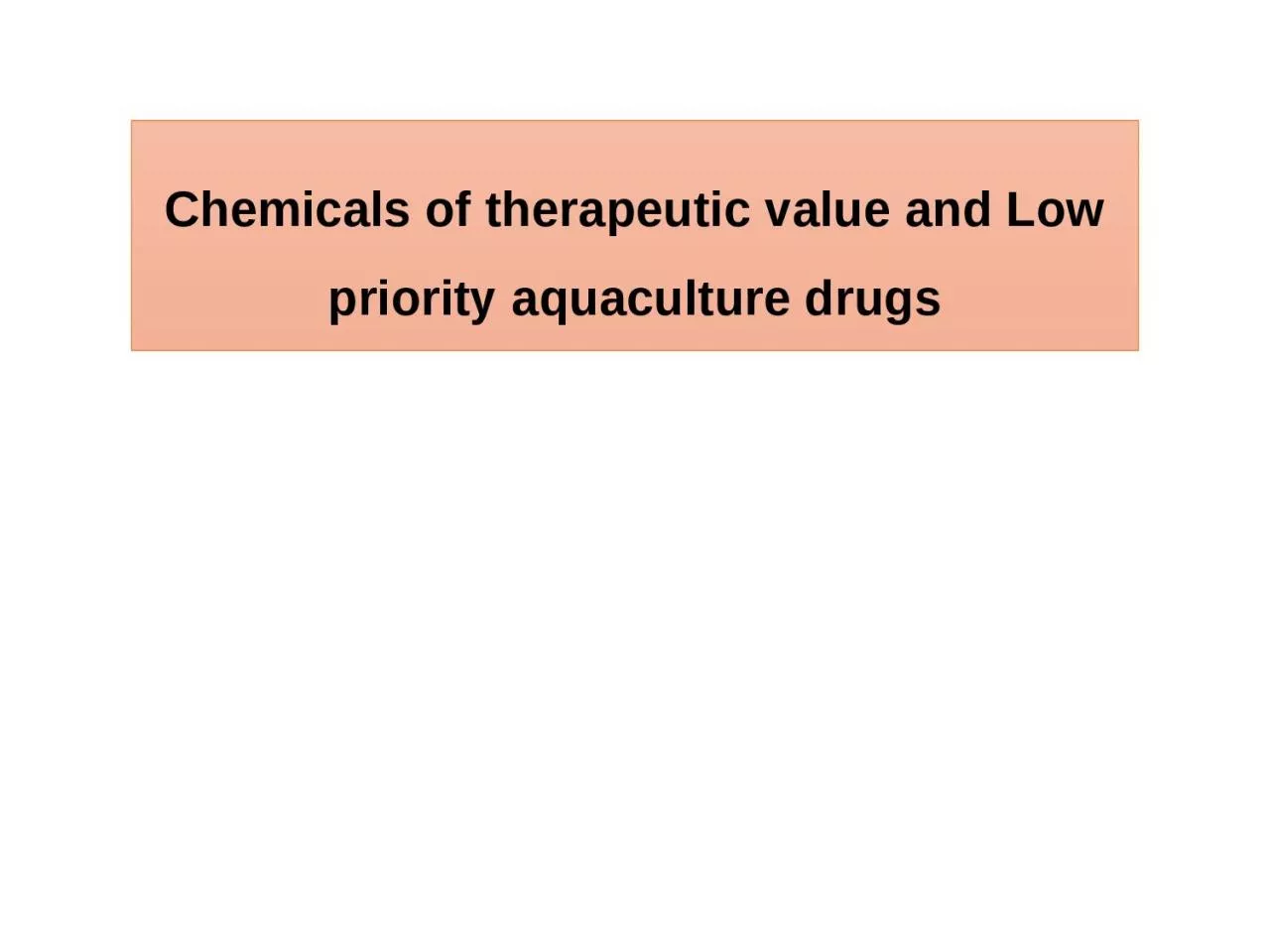

Chemical Chemical is a distinct compound or substance especially one which has been artificially prepared or purified or extracted from natural sources Compound Thing consisting of several parts or elements ID: 1030414
Download Presentation The PPT/PDF document "Chemicals of therapeutic value and Low p..." is the property of its rightful owner. Permission is granted to download and print the materials on this web site for personal, non-commercial use only, and to display it on your personal computer provided you do not modify the materials and that you retain all copyright notices contained in the materials. By downloading content from our website, you accept the terms of this agreement.
1. Chemicals of therapeutic value and Low priority aquaculture drugs
2. Chemical Chemical is a distinct compound or substance, especially one which has been artificially prepared or purified or extracted from natural sources.Compound: Thing consisting of several parts or elements.Elements are chemically the simplest pure substances (made up of one types of atom) which cannot be broken down into another substances.
3.
4. TherapeuticTherapeutic is a branch of medicine that is concerned specifically with the treatment of disease.Sources of Therapeutic chemical compoundTherapeutic agents are obtained from 6 major sources-Plants sourcesAnimals sourcesMinerals or Earth sourcesMicrobiological sources Synthetic sourcesRecombinant DNA technology
5. Plant sourcesAll most all parts of the plant are used- stem, leaves, bark, fruit and root.Leaves:The leaves of Digitalis purpurea are the source of Digitoxin and Digoxin, which are cardiac glycosides.Leaves of Eucalyptus gives oil of Eucalyptus, which is important component of cough syrup.Tobacco leaves give nicotine.
6. RotenoneInsecticide, piscicide, and pesticide. It occurs naturally in the seeds and stems of several plants, such as the jicama vine plant, and the roots of several members of Fabaceae plant.Rotenone is produced by extraction from the roots and stemRotenone works by interfering with the electron transport chain in mitochondria.Rotenone also inhibits microtubule assembly.
7. SaponinSaponins are glucosides with foaming characteristics. Saponins consist of a polycyclic aglycones attached to one or more sugar side chains. The foaming ability of saponins is caused by the combination of a hydrophobic (fat-soluble) sapogenin and a hydrophilic (water-soluble) sugar part. Saponins have a bitter taste. Saponins toxin are known as sapotoxin.
8. The best known sources of saponins are peas, soybeans, and some herbs with names indicating foaming properties such as soapwort, saoproot, soapbark and soapberry. Commercial saponins are extracted mainly from Yucca schidigera and Quillaja saponaria.Yucca schidigera Quillaja saponaria
9. Animal sourcesPancreas is a source of Insulin, used in treatment of Diabetes.Urine of pregnant women gives human chorionic gonadotropin (hCG) used for treatment of infertility.Sheep thyroid is a source of thyroxin, used in hypertension.Cod liver oil is used as a source of Vitamin A and D.Blood is used in preparation of vaccine.
10. Mineral sourcesIron is used in treatment of iron deficiency anaemia.Zinc is used as zinc supplement. Zinc oxide paste is used in wounds.Iodine is antiseptic. Iodine supplement are also used in diet.Fluorine has a antiseptic properties.Selenium sulphide is used in anti dandruff shampoos.
11. Synthetic sourcesSynthetic drugs are manufactured to pharmacologically resemble naturally occurring drugs.Example- Emetine bismuth Iodide, Apomorphine, Ampicillin, Methyl testosterone etc.Microbial sourcesPenicillium notatum is a fungus which release penicillin.Actinobacteria give Streptomycin.Aminoglycosides such as gentamicin obtained from Streptomyces.
12. Antimycin AAntimycin A is a secondary metabolites produced by Streptomyces bacteria.Antimycin A is the active ingredient in Fintrol, a chemical piscicide (fish poison) used in Aquaculture.Antimycin A is an inhibitor of cellular respiration, specifically oxidative phosphorylation.
13. Recombinant DNA technologyRecombinant DNA technology involves cleavage of DNA by enzyme restriction endonucleases.The desired gene is coupled to rapidly replicating DNA (Viral, Bacterial or Plasmid).The new genetic combination is inserted into the bacterial cultures which allow production of vast amount of genetic material.Advantage:Huge amount of drugs can be produced.Drug can be obtained in pure form.
14. Low Regulatory Priority (LRP) DrugsLRP drugs are harmless compounds that have historically been used in aquaculture but will likely never be approved by FDA.List of LRP are: SL NODrug name Application / Action1Acetic acidParasiticide2Calcium ChlorideEgg hardening3Calcium Oxide Protozoacide4Carbon dioxide gasAnaesthetic5Fuller’s earthReduce egg adhesion6GarlicParasiticide7IceReduce metabolic rate
15. SL NODrugs NameApplication / Action1Magnesium SulfateParasiticide2OnionParasiticide3PapainRemove egg mass gelatinous material4Potassium ChlorideOsmoregulation5Povidone iodine Egg surface disinfectant6Sodium bicarbonateanaesthetic7Thiamine hydrochlorideThiamine deficiency in Salmonids8Sodium ChlorideOsmoregulation9Sodium SulfiteImprove egg hatchability1011Urea and Tannic acidClove OilDenature egg adhesionAnaesthetic
16. Assignment for Group-1(FSP)Dated…. Case study reportTopic: Case study of village fish farmerPoint to be write:1. Name of Farmer, Information about pond/farm/ area etc.2. Mannuring/fertilizer/liming schedule3. Feeding4. Treatment of weed fish and aquatic weedsSubmitted by: your name, registration numberSend it to me, Email: tasok.leya@cutm.ac.in
17. Assignment for Group-2 (FSP)Dated….Case study reportTopic: Case study report on fish epidemiologyPoint to be write:1. Farmer name, pond detail2. Details of Fish seed source3. Prophylaxis schedule4. Details of EpidemiologySubmitted by: your name, registration numberSend it to me, Email: tasok.leya@cutm.ac.in